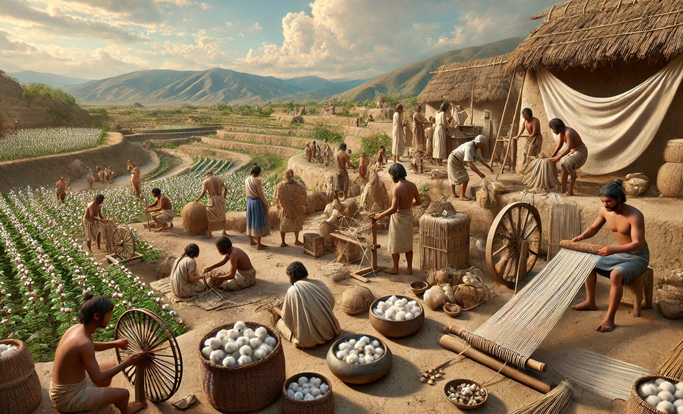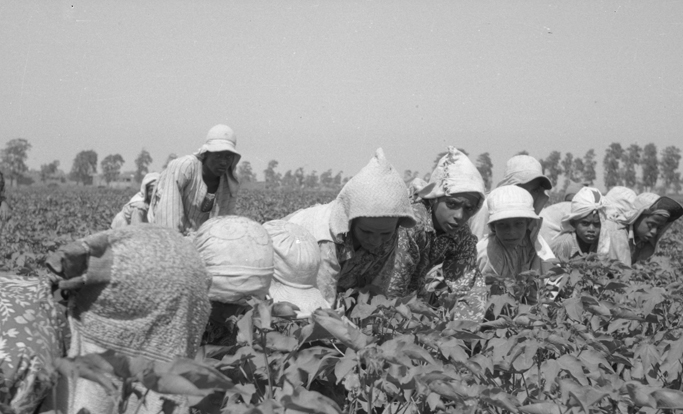Ancient Beginnings
Did you know that the earliest evidence of cotton use dates back to around 5500 BC in the Indus Valley region? Fascinatingly, fibers were found preserved in copper beads at the archaeological site of Mehrgarh, which is in present-day Pakistan. This shows us that ancient societies were embracing cotton fibers over 7,000 years ago!
Similarly, across the ocean in the Americas, cotton was really important in ancient cultures as well. For instance, in Peru, we can trace cotton cultivation and textile production back to 4200 BC, emphasizing its central role in the early Andean societies. Isn’t that amazing?

Spread Across Continents
Around 5000 BC, cotton cultivation flourished in East Africa, especially near the beautiful Nile River. The unique species that thrived there could even grow in dry conditions, showcasing how adaptable this remarkable plant is!
Meanwhile, in China during the Han Dynasty (207 BC – 220 AD), cotton found its place in the lush southern province of Yunnan, highlighting how it became an integral part of diverse cultures throughout Asia.

Medieval Advancements
The Middle Ages saw significant developments in cotton processing. Handheld roller cotton gins were utilised in India as early as the 6th century, facilitating the more efficient separation of fibres from seeds. Dual-roller gins emerged between the 12th and 14th centuries in India and China, further advancing cotton processing techniques.
Cotton’s introduction to Europe occurred during the medieval period, primarily through the Muslim conquest of the Iberian Peninsula and Sicily. By the 12th century, knowledge of cotton weaving had spread to northern Italy, and the fiber became increasingly popular across the continent. The spinning wheel, introduced to Europe around 1350, improved the efficiency of cotton spinning, leading to the establishment of cotton trade hubs in cities like Venice and Antwerp by the 15th century.

The Industrial Revolution and the Global Expansion of Cotton Production
The 18th-century Industrial Revolution marked a turning point in cotton manufacturing. Innovations such as the spinning jenny, water frame, and power loom revolutionised textile production, transitioning it from a cottage industry to large-scale factory-based manufacturing. These advancements significantly increased cotton demand, transforming it into one of the most essential commodities of the global economy.
During the early 19th century, Mohammed Ali Pasha, the ruler of Egypt, recognised cotton’s economic potential and took bold steps to establish Egypt as a major cotton producer. Seeing an opportunity to integrate Egypt into the expanding global textile market, he introduced long-staple cotton (Gossypium barbadense), commonly known as “Egyptian cotton.” This variety was prized for its exceptional softness and durability, making it highly sought after in European textile mills.
To ensure full control over the cotton industry, Mohammed Ali Pasha nationalized land and enforced strict government oversight on cotton cultivation and trade. Farmers were required to grow cotton as a cash crop, and the state managed its sale, securing lucrative deals with British and French textile manufacturers. Under his rule, Egypt became one of the most important suppliers of high-quality cotton to Europe, a legacy that continues today.
At the same time, across the Atlantic, the U.S. Deep South emerged as the world’s leading cotton producer, primarily due to the exploitation of enslaved African laborers. Before the invention of the cotton gin in 1793 by Eli Whitney, separating cotton fibers from seeds was labor-intensive and slow. However, with the cotton gin, processing raw cotton became significantly faster, leading to an explosion in cotton production.
By the mid-19th century, the Southern United States supplied over 75% of the world’s cotton, feeding the booming textile industries of Britain and Europe. This economic expansion, however, was built on the forced labor of millions of enslaved people, who endured brutal working conditions on plantations. Cotton profits fueled the economy of the South and strengthened its reliance on slavery, contributing to the deep economic and political divisions that ultimately led to the American Civil War (1861-1865).

Modern Era
Today, cotton remains a cornerstone of the textile industry, valued for its comfort, durability, and versatility. Advancements in agricultural practices and biotechnology have led to improved yields and pest-resistant varieties, ensuring cotton’s continued prominence in global markets.
From its ancient roots to its modern applications, cotton’s evolution reflects the dynamic interplay between human innovation and natural resources, weaving a fabric that continues to envelop our daily lives.



